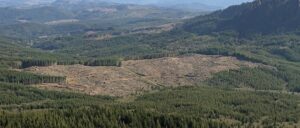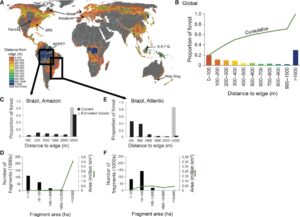Human impact reaches further than what one might expect. Although some may be obvious and documented, their full effect on the ecosystem is sometimes underestimated. Take forests for example, when you think of forests, what you might have in mind is large swaths of trees spreading far and wider than the horizon of the eye could see. In reality, most forests are ‘patchy’ and fragmented.

A shocking statistic from a group of scientists from Science Advances have found that the remaining 70% of forests left on Earth are within an edge from a kilometre away. Their findings also suggest that these fragments have caused a loss of 13 to 75% of biodiversity in said forests. These effects only worsen with time since the smallest fragmentation can have a large area of forest by simply exposing it to an unforested edge.

You might be wondering what effects are brought upon by having just a simple unforested edge, the fact is that these edges expose the nearby area with light, noise, pollution, and many others. These extra artificial stimulants caused by deforestation can cause microclimate changes near the edge, affecting the trees and vegetation by having an abnormal characteristic of soil, temperature, and humidity changes to name a few (Aspelin 2018).
Unfortunately, whenever human will inevitably build roads and develop the area around them, affecting yet deeper parts of the forests. For example, 95% of deforestations occur within 5.5 kilometres of a road (Barber et al. 2018). Thus, with roads penetrating deep into forests, conservationist are currently debating whether to focus efforts into SLOSS (Single large or several small) and what to prioritize to have the greatest impact in reducing human impact on our already very scarce forests.
Sources
‘Habitat fragmentation and its lasting impact on Earth’s ecosystems’ 2015, Science Advances, 20 March, vol. 1, no. 2, viewed 11 March 2024, <https://www.science.org/doi/10.1126/sciadv.1500052#bibliography>.
Aspelin, M 2018, When it comes to habitat, having an edge is not a good thing, GreenBiz, viewed 12 March 2024.
Barber, CP, Cochrane MA, Souzana, CM, Laurance, WF 2014, ‘Roads, deforestation, and the mitigating effect of protected areas in the Amazon, Science Direct, Vol. 177, pp. 203-209.

Have humanities had any attempts in restoring the current state of wide unforested area due to the large-scale deforestation over the world other than just trying to reduce the impact of it and what are the necessaries means taken by the general publics to prevent it, for instance setting up a common “rules” for limitation in deforestation.
Yes, there has been many efforts in which humanity tries to prevent deforestation at a wide scale. The best example on a national level is by Costa Rica’s novel government program called Pago por Servicios Ambientales (PSA)—Payment for Environmental Services. The PSA offers money to landholders to conserve the trees in the area. This not only decreases the rate of deforestation in the country, but also increased the inflation-adjusted GDP per capita of its citizen by 70% since the PSA program began. This shows that incentivizing the public is very effective in conserving forests if done properly.
How interesting! Are there any ways to help mitigate the damage caused by impact fragmentation and help natural habitats return to normal?
Yes! As said in my comment to Danish, governments and organizations can give financial incentives to conserve forests. A recent example literally a day ago is Vietnam, which received $51.5m in carbon credits from World Bank, biggest to date.
As you’ve said, humanity has well left its mark on the natural environment. Based on our growing carbon footprint that stretches farther and farther across the globe by each passing year, deforestation has already begun chipping away at the lush beauty of the wilderness. Do you have any alternatives in mind as opposed to letting this practice be the supporting trigger to the eventual destruction of the environment?
Yes, as said in my comment to Danish, financial incentives are powerful. However as an alternative its merely a bandage. Since the main cause of deforestation is due to primarily locals seeking development and areas for industrialization or agriculture. A poorer demographic will always demand developments at the cost of environment since it is the easiest way to grow their local economy. The truth is that there is no perfect alternative to deforestation, the best we can do it to mitigate its impact and make it sustainable, and that is exactly what organizations around the world is doing.